Recurrent Neuronal Networks for the Prediction of the Temperature of a Synchronous Machine During Its Operation
Abstract
1. Introduction
2. Materials and Methods
2.1. Experimental Setup
2.2. Data Set Description
2.3. Experimental Results
2.4. Long Short-Term Memory Neural Network
3. Results
4. Conclusions
5. Patents
Author Contributions
Funding
Data Availability Statement
Conflicts of Interest
Abbreviations
| MAE | Mean Absolute Error |
| MSE | Mean Squared Error |
| LSTM | Long Short-Term Memory |
| PMSM | Permanent Magnet Synchronous Machine |
| RMSE | Root Mean Squared Error |
| RNN | Recurrent Neural Network |
| SM | Synchronous Machine |
References
- IEEE Std C37.102-2023 (Revision of IEEE Std C37.102-2006); IEEE Guide for AC Generator Protection. IEEE: Piscataway, NJ, USA, 2024; pp. 1–211.
- UNE-EN 60034-1:2001; Máquinas Eléctricas Rotativas. Parte 1: Características Asignadas y Características de Funcionamiento. UNE: Madrid, Spain, 2001.
- IEEE Std C50.13-2014 (Revision of IEEE Std C50.13-2005); IEEE Standard for Cylindrical-Rotor 50 Hz and 60 Hz Synchronous Generators Rated 10 MVA and Above. IEEE: Piscataway, NJ, USA, 2014; pp. 1–63.
- IEEE Std C50.12-2005 (Previously Designated as ANSI C50.12-1982); IEEE Standard for Salient-Pole 50 Hz and 60 Hz Synchronous Generators and Generator/Motors for Hydraulic Turbine Applications Rated 5 MVA and Above. IEEE: Piscataway, NJ, USA, 2006; pp. 1–45.
- IEC 60034-11:2020; Rotating Electrical Machines. Part 11: Thermal Protection. International Electrotechnical Commission: Geneva, Switzerland, 2020.
- Jiang, S.; Wang, L.; Wang, L.; Ye, P.; Hao, Z. A new thermal protection approach for permanent magnet synchronous motor. In Proceedings of the IECON 2013—39th Annual Conference of the IEEE Industrial Electronics Society, Vienna, Austria, 10–13 November 2013; pp. 2536–2540. [Google Scholar]
- Mocanu, R.; Onea, A. Determination of stator temperature for thermal protection in a permanent magnet synchronous machine. In Proceedings of the 25th Mediterranean Conference on Control and Automation (MED), Valletta, Malta, 3–6 July 2017; pp. 1321–1325. [Google Scholar]
- Wang, L.; Kou, B.; Cai, W. Research on resistance enhancement coefficient and thermal dissipation of stator strands in huge synchronous generator. IEEE Access 2020, 8, 40357–40366. [Google Scholar] [CrossRef]
- Tong, W.; Wu, S.; Tang, R. Research on the airflow and thermal performance in a large forced air-cooled permanent magnet synchronous machine. IEEE Access 2019, 7, 162343–162352. [Google Scholar] [CrossRef]
- El Halabi, N.; Donolo, M.; Donolo, P.; Rajab, T. Synchronous rotor thermal model based on stator current modulation. J. Eng. 2018, 2018, 866–870. [Google Scholar] [CrossRef]
- Sun, T.; Wang, J.; Griffo, A.; Sen, B. Active thermal management for interior permanent magnet synchronous machine (ipmsm) drives based on model predictive control. IEEE Trans. Ind. Appl. 2018, 54, 4506–4514. [Google Scholar] [CrossRef]
- Jiang, Y.; Yu, Y.; Huang, J.; Cai, W.; Marco, J. Li-ion battery temperature estimation based on recurrent neural networks. Sci. China Technol. Sci. 2021, 64, 1335–1344. [Google Scholar] [CrossRef]
- Zhu, S.; He, C.; Zhao, N.; Sha, J. Data-driven analysis on thermal effects and temperature changes of lithium-ion battery. J. Power Sources 2021, 482, 228983. [Google Scholar] [CrossRef]
- Zachary, C.; Berkowitz, J. Critical Review of Recurrent Neural Networks for Sequence Learning. arXiv 2015, arXiv:1506.00019. [Google Scholar]
- Saeed, M.; El-Saadawi, M. Practical Implementation and Testing of RNN Based Synchronous Generator Internal Fault Protection. Recent Adv. Electr. Electron. Eng. 2019, 12, 181–189. [Google Scholar] [CrossRef]
- Ida, S.; Darwin, S.; Fantin, E. A deep residual neural network model for synchronous motor fault diagnostics. Appl. Soft Comput. 2024, 160, 111683. [Google Scholar]
- Guo, H.; Ding, Q.; Song, Y.; Tang, H.; Wang, L.; Zhao, J. Predicting Temperature of Permanent Magnet Synchronous Motor Based on Deep Neural Network. Energies 2020, 13, 4782. [Google Scholar] [CrossRef]
- Bingi, K.; Rajanarayan, B.; Kumra, A.; Chawla, A. Torque and Temperature Prediction for Permanent Magnet Synchronous Motor Using Neural Networks. In Proceedings of the 2020 3rd International Conference on Energy, Power and Environment: Towards Clean Energy Technologies, Shillong, India, 5–7 March 2021; pp. 1–6. [Google Scholar]
- Thosar, P.; Patil, J.; Singh, M.; Thamke, S.; Gonge, S. Prediction of Motor Temperature using Linear Regression. In Proceedings of the 2020 International Conference on Smart Technologies in Computing, Electrical and Electronics (ICSTCEE), Bengaluru, India, 9–10 October 2020; pp. 7–12. [Google Scholar]
- Hughes, R.; Haidinger, T.; Pei, X.; Vagg, C. Real-time temperature prediction of electric machines using machine learning with physically informed features. Energy AI 2023, 14, 100288. [Google Scholar] [CrossRef]
- Cen, Y.; Zhang, C.; Cen, G.; Zhang, Y.; Zhao, C. The Temperature Prediction of Permanent Magnet Synchronous Machines Based on Proximal Policy Optimization. Information 2020, 11, 495. [Google Scholar] [CrossRef]
- Swidenbank, E.; Mcloone, S.; Flynn, D.; Irwin, G.; Brown, M.; Hogg, B. Neural network-based control for synchronous generators. IEEE Trans. Energy Convers. 2000, 14, 1673–1678. [Google Scholar] [CrossRef]
- Tang, P.; Zhao, Z.; Li, H. Short-Term Prediction Method of Transient Temperature Field Variation for PMSM in Electric Drive Gearbox Using Spatial-Temporal Relational Graph Convolutional Thermal Neural Network. IEEE Trans. Ind. Electron. 2024, 71, 7839–7852. [Google Scholar] [CrossRef]
- Pascual, R.; Mahtani, K.; Rivero, E.; Platero, C.A. Brushless Synchronous Machine Field Winding Interturn Fault Severity Estimation Through Deep Neural Networks. IEEE Trans. Energy Convers. 2024, 39, 1341–1351. [Google Scholar] [CrossRef]
- Barrera-Cardenas, R.; Perez-Londoño, S.; Mora-Florez, J. Artificial neural networks applied to synchronous machine modeling: A review. Tecnura 2010, 14, 109–122. [Google Scholar]
- Wang, P.; Wang, X.; Wang, Y. End-to-End Differentiable Physics Temperature Estimation for Permanent Magnet Synchronous Motor. World Electr. Veh. J. 2024, 15, 174. [Google Scholar] [CrossRef]
- Zhu, Y.; Xiao, M.; Lu, K.; Wu, Z.; Tao, B. A Simplified Thermal Model and Online Temperature Estimation Method of Permanent Magnet Synchronous Motors. Appl. Sci. 2019, 9, 3158. [Google Scholar] [CrossRef]
- Sun, L.; Dhale, S.; Nalakath, S.; Mohamadian, M.; Luedtke, D.; Preindl, M.; Emadi, A. Non-Linear Optimization-Based Temperature Estimation of IPMSM. In Proceedings of the 2019 IEEE Transportation Electrification Conference and Expo (ITEC), Detroit, MI, USA, 19–21 June 2019; pp. 1–7. [Google Scholar]
- Shafieeroudbari, E.; Iyer, L.; Kar, N. Real-Time Rotor Temperature Estimation in Permanent Magnet Synchronous Motor Using Incremental Deep Learning. In Proceedings of the 2024 International Conference on Electrical Machines (ICEM), Torino, Italy, 1–4 September 2024; pp. 1–6. [Google Scholar]
- Foda, S.G.; Abdel-Rahman, M.H.; Addoweesh, K.E. Fault detection in large AC machines. In Proceedings of the ICM 2001 Proceedings. The 13th International Conference on Microelectronics, Rabat, Morocco, 29–31 October 2001; pp. 193–196. [Google Scholar]
- Tang, J.; Liu, Y.; Lundberg, S. Estimation Algorithm for Current and Temperature of Field Winding in Electrically Excited Synchronous Machines with High-Frequency Brushless Exciters. IEEE Trans. Power Electron. 2021, 36, 3512–3523. [Google Scholar] [CrossRef]
- Savitzky, A.; Golay, M.J.E. Smoothing and Differentiation of Data by Simplified Least Squares Procedures. Anal. Chem. 1964, 36, 1627–1639. [Google Scholar] [CrossRef]
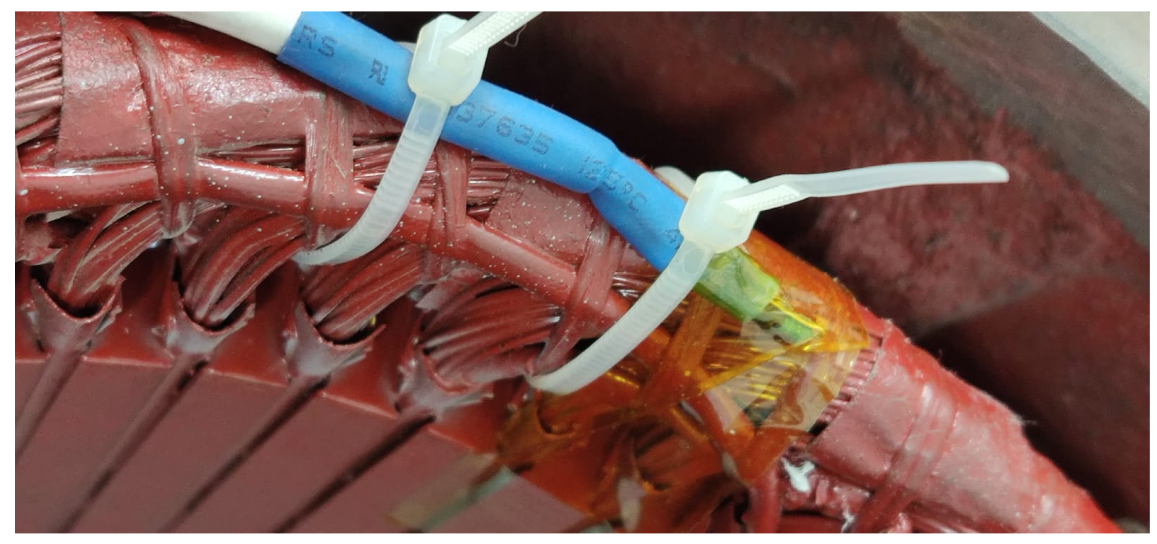
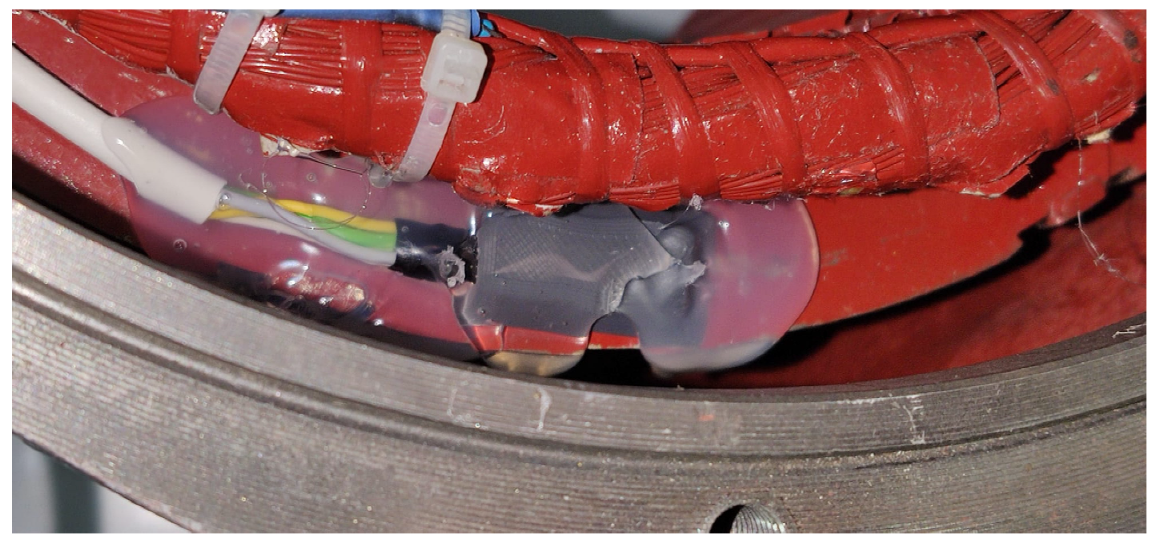
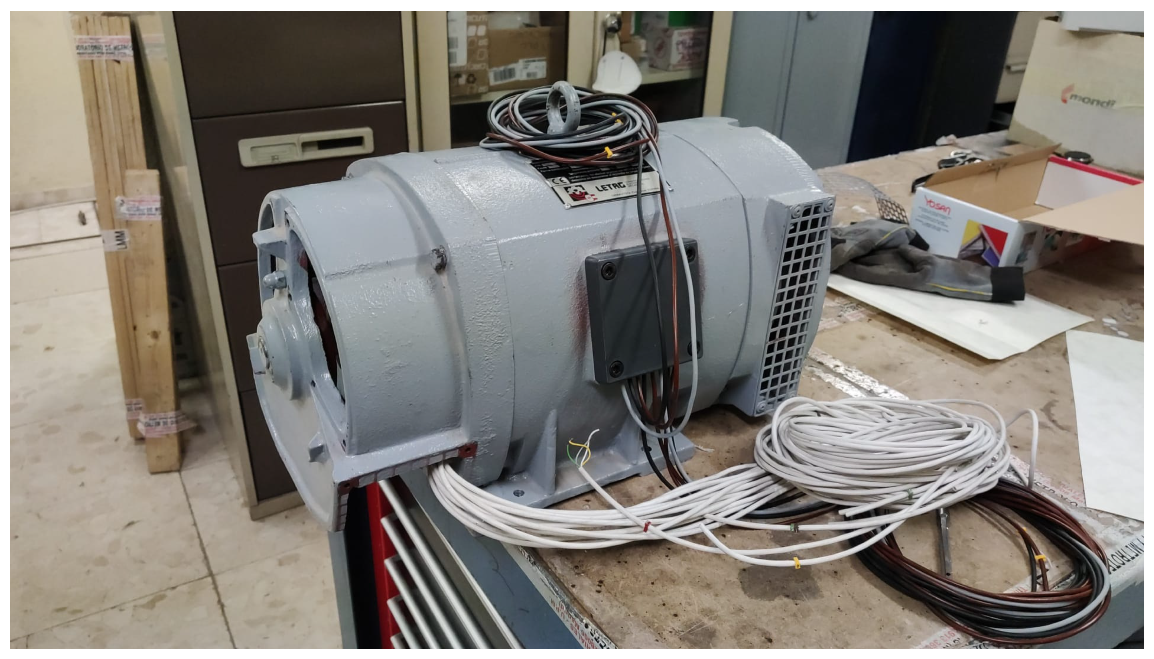

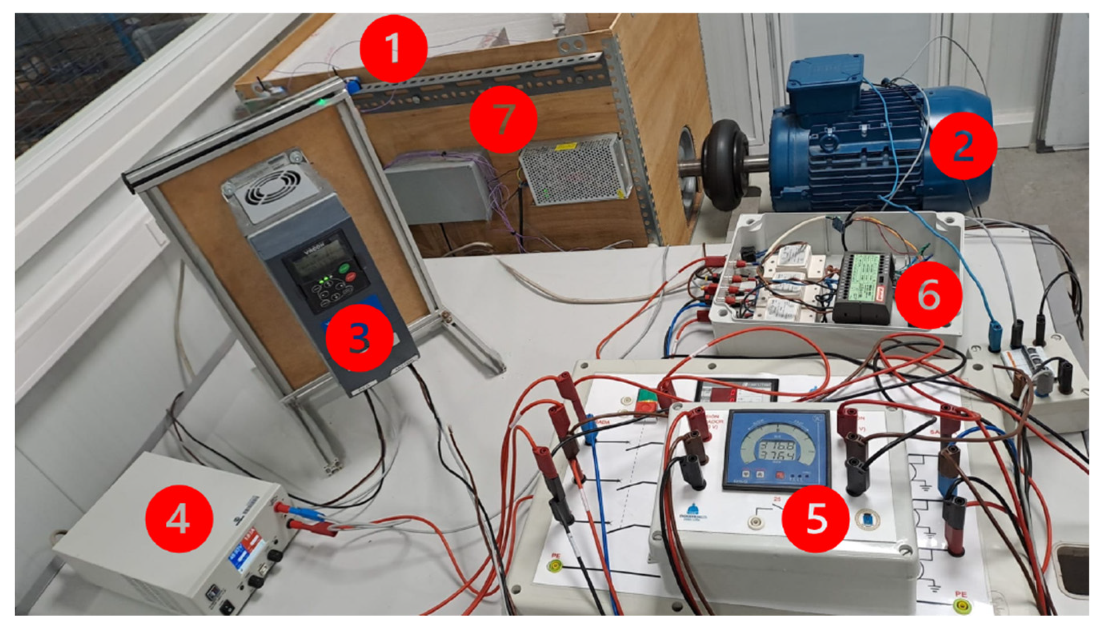
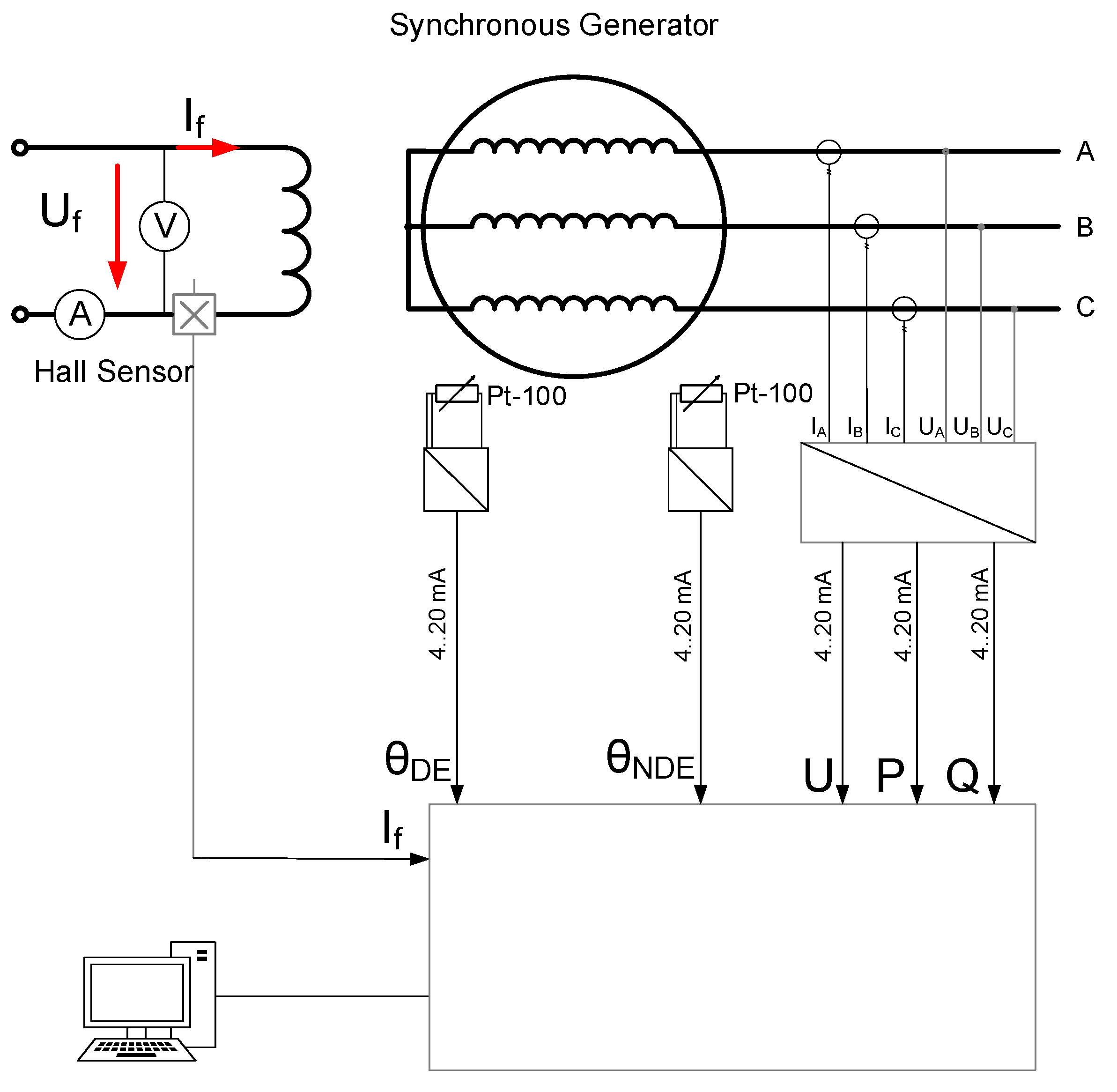
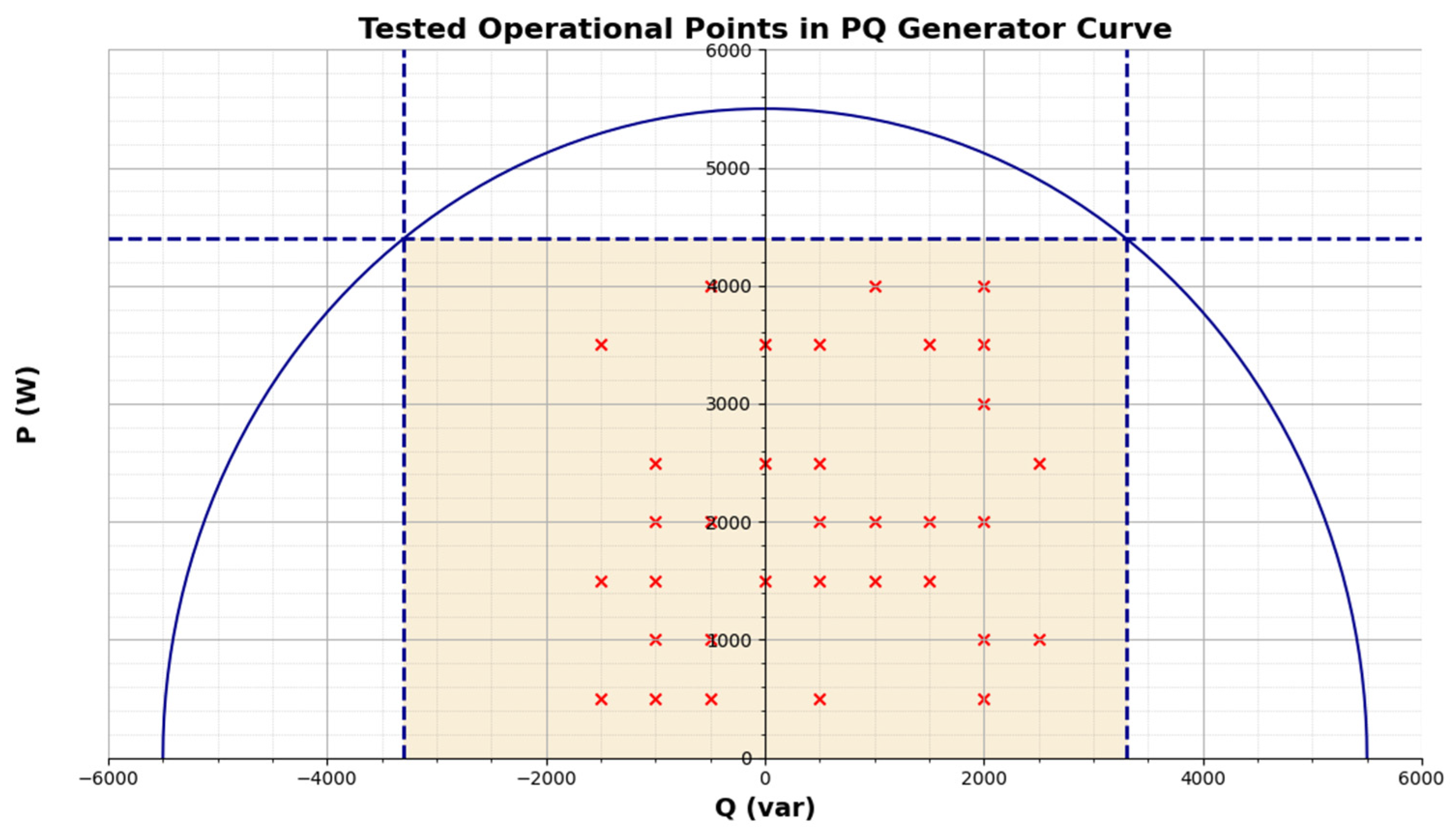
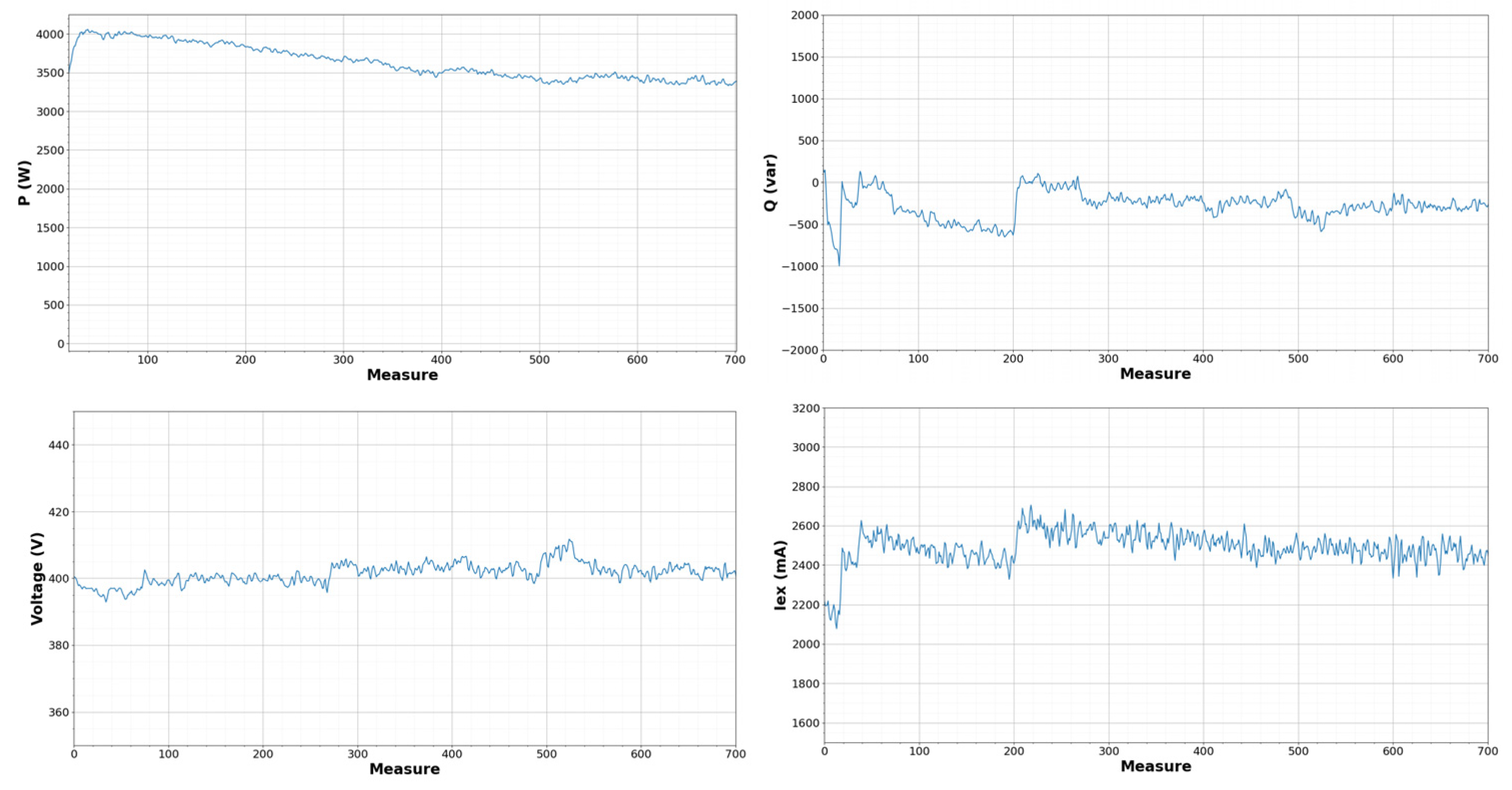
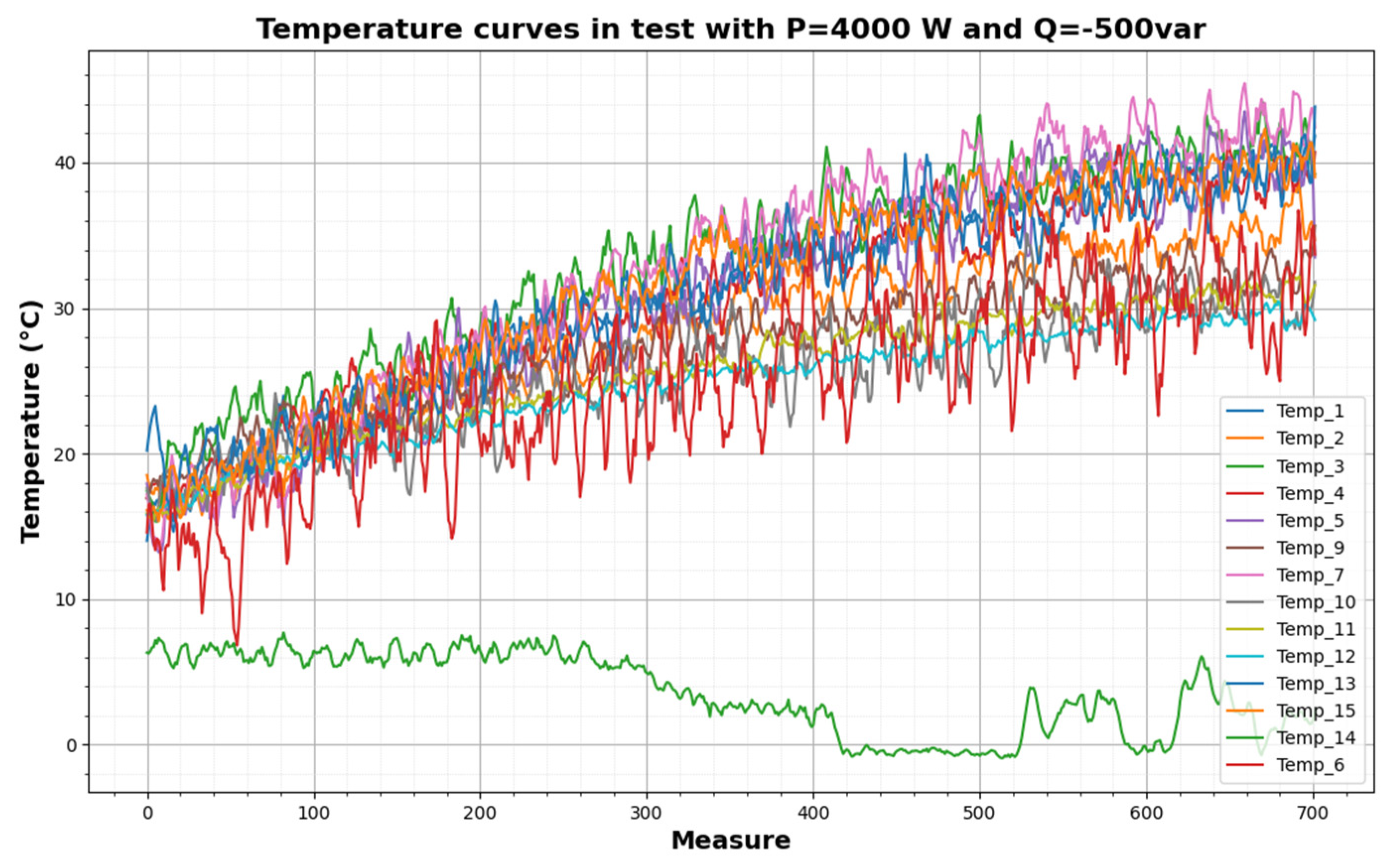
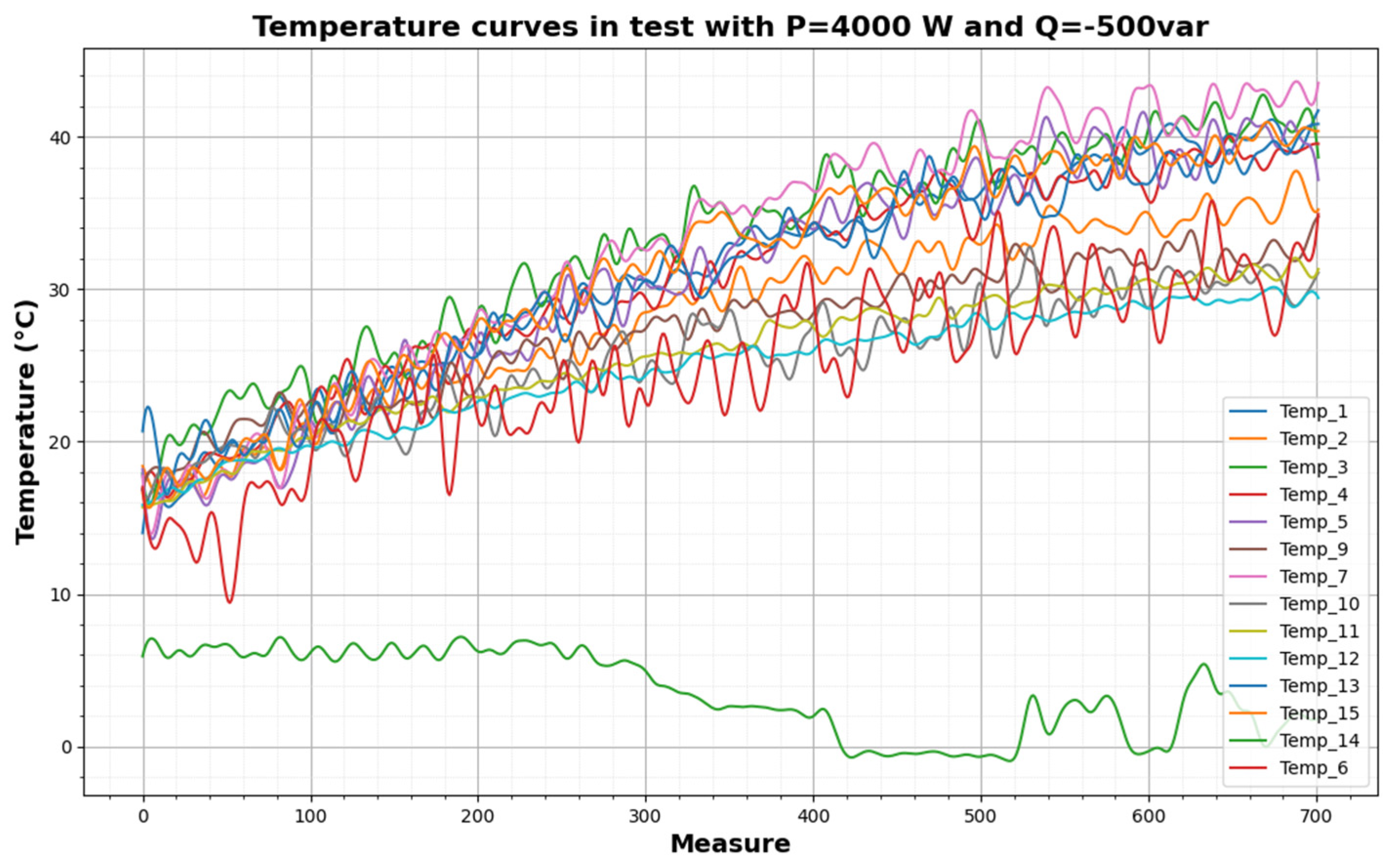
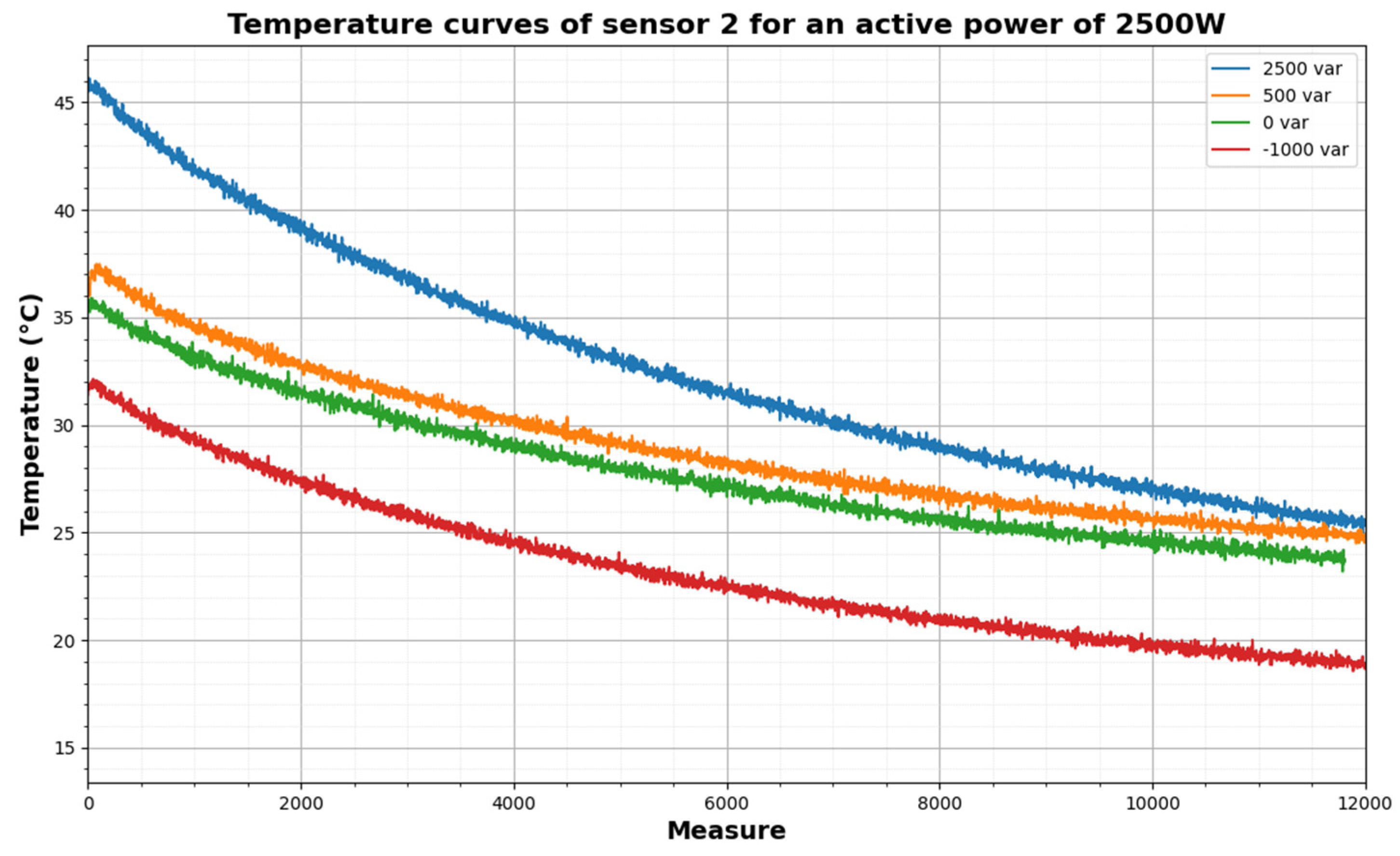
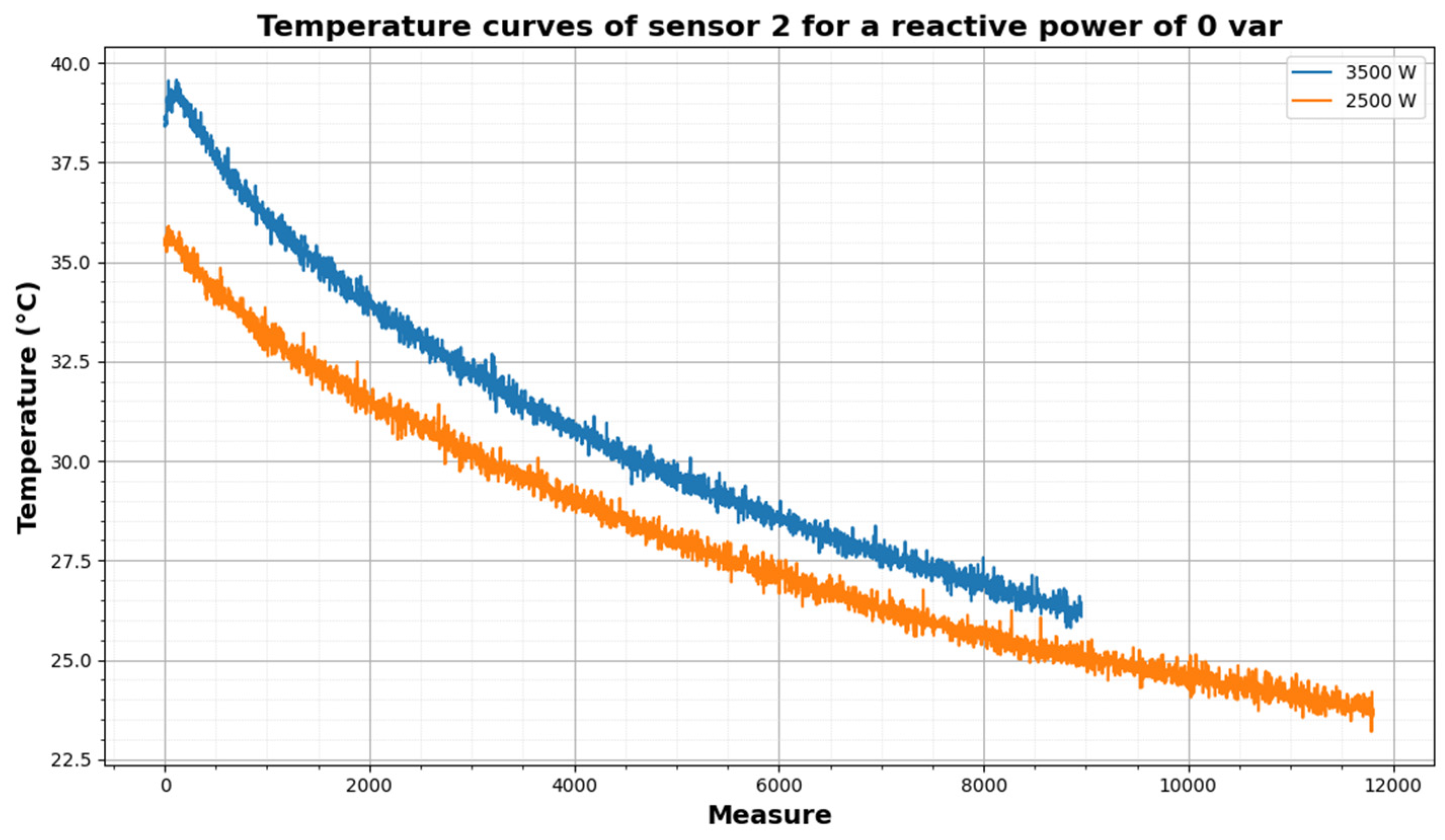
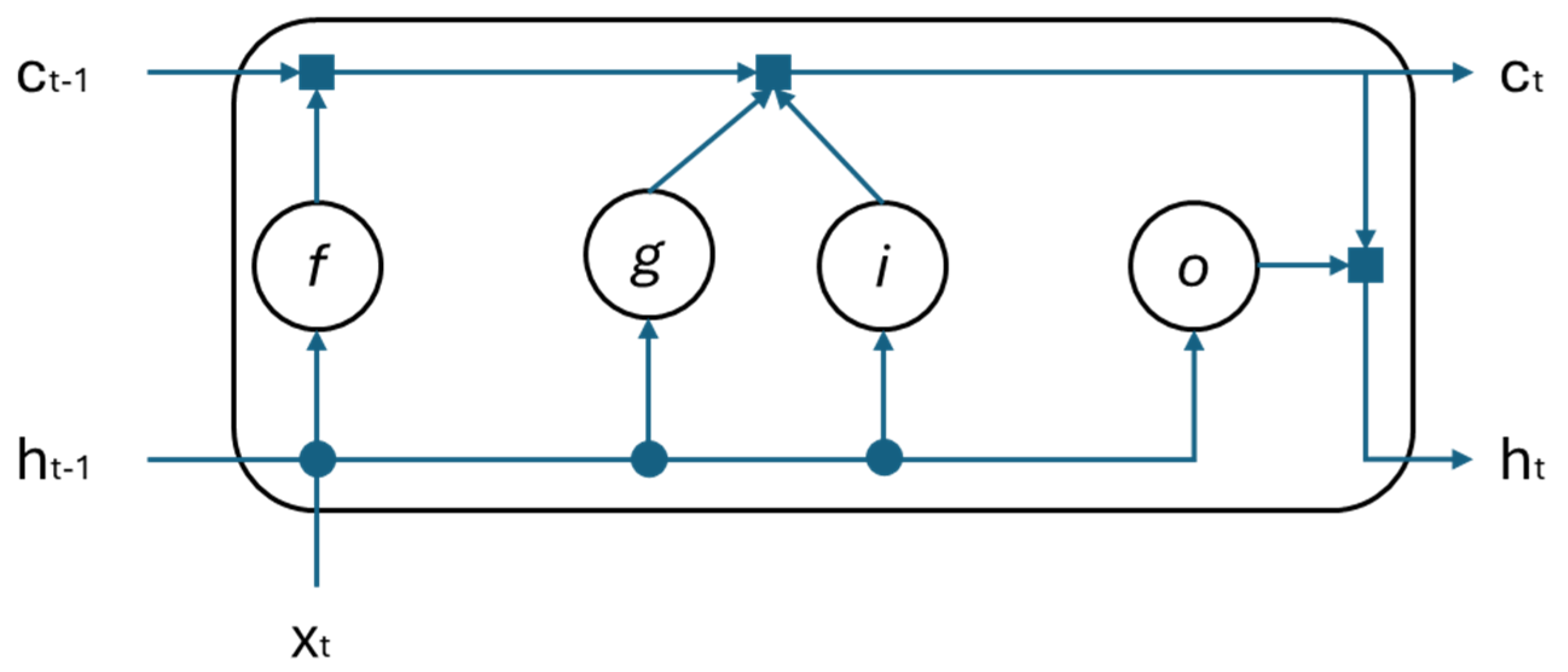
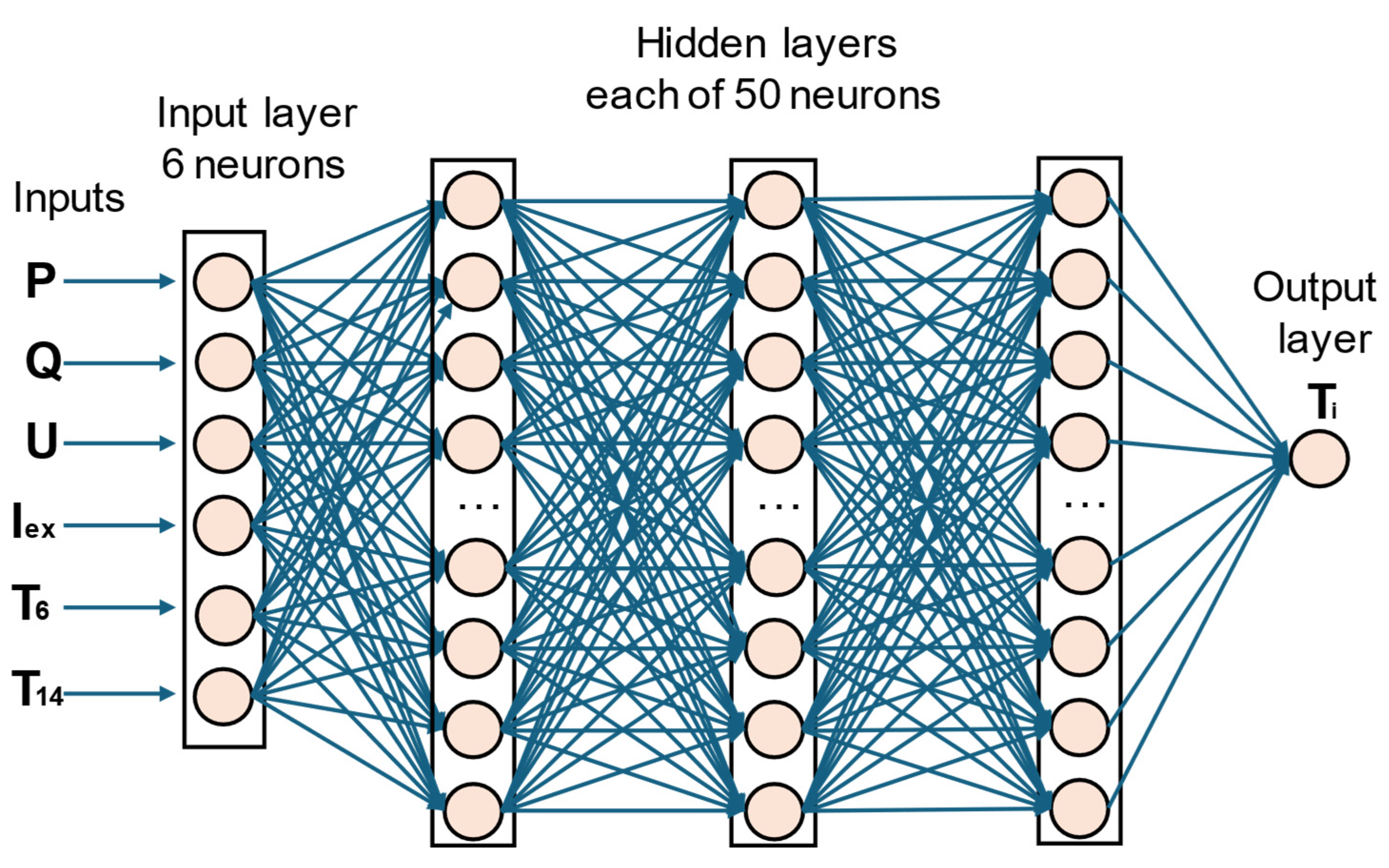


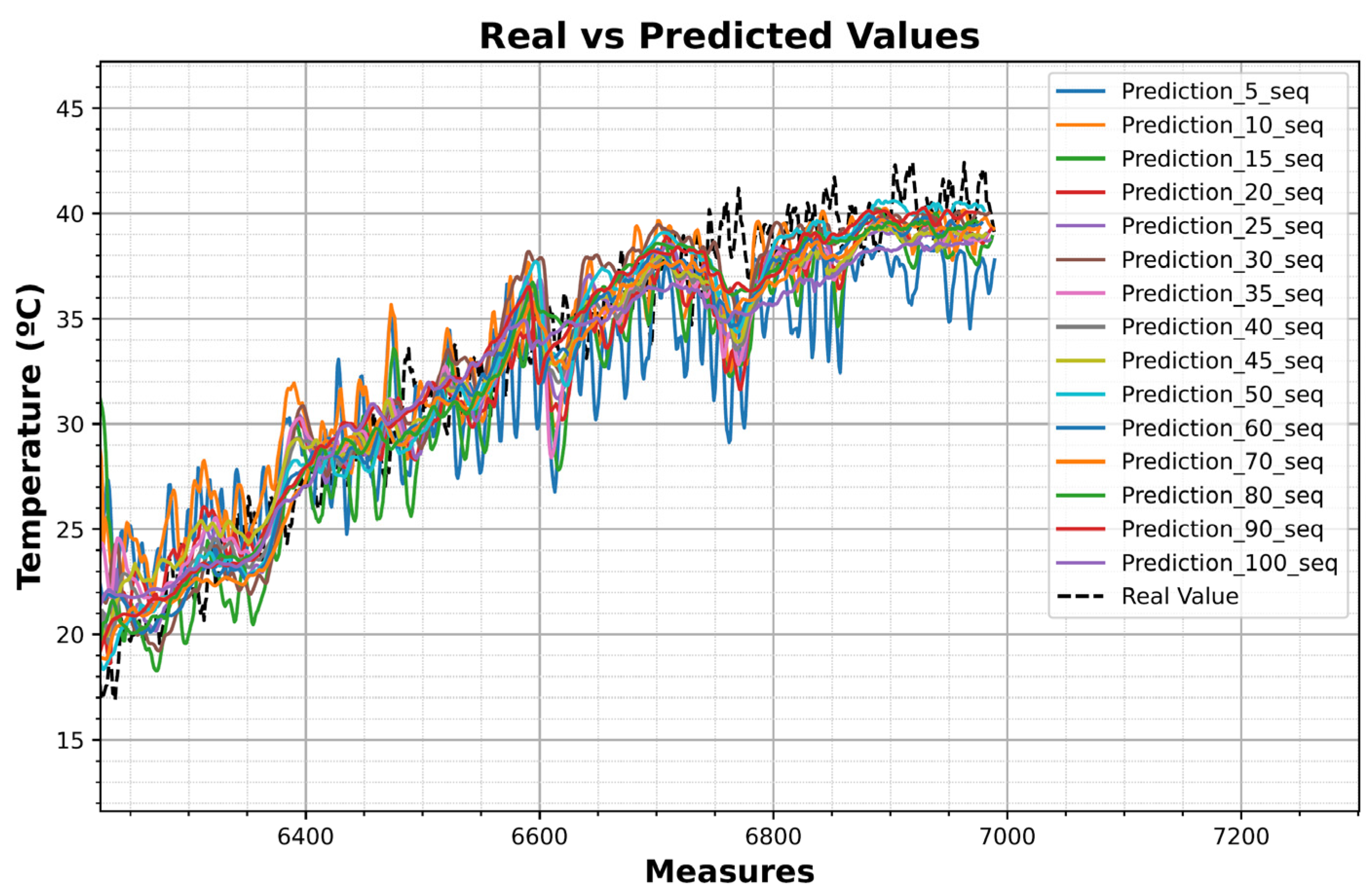

| Alternator Type | Synchronous 3-Phase with Static Excitation | |
|---|---|---|
| Rated capacity | 5.5 | kVA |
| Rated speed | 1000 | rpm |
| Rated voltage | 400 | V |
| Rated current | 7.9 | A |
| Pole pairs | 3 | |
| Rated frequency | 50 | Hz |
| IP | 21 | |
| Insulation class | F | |
| Rated excitation voltage | 110 | V |
| Rated excitation current | 3.60 | A |
| Rated power factor | 0.8 | |
| Test | Active Power [W] | Reactive Power [var] |
|---|---|---|
| 1 | 500 | [−1500, 2000] |
| 2 | 1000 | [−1000, 2500] |
| 3 | 1500 | [−1500, 1500] |
| 4 | 2000 | [−1000, 2000] |
| 5 | 2500 | [−1000, 2500] |
| 6 | 3000 | 2000 |
| 7 | 3500 | [−1500, 2000] |
| 8 | 4000 | [−500, 2000] |
| Parameter | Heating LSTM | Cooling LSTM |
|---|---|---|
| Number of layers | 5 | 5 |
| Number of inputs | 6 | 2 |
| Inputs | P, Q, U, Iex, T6, T14 | T6, T14 |
| Number of outputs | 1 | 1 |
| Output | Ti | Ti |
| Number of hidden layers | 3 | 3 |
| Number of neurons in hidden layers | 50 | 30 |
| Optimizer | Adam | Adam |
| Loss | MSE | MSE |
| Number of epochs | 30 | 30 |
| Early Stopping | 2 epochs | 2 epochs |
| Number of Sequences/Parameter | MSE * | MAE * | RMSE * |
|---|---|---|---|
| 5 | 13.34 | 2.84 | 3.65 |
| 10 | 10.49 | 2.50 | 3.24 |
| 15 | 9.33 | 2.25 | 3.05 |
| 20 | 7.72 | 2.17 | 2.78 |
| 25 | 6.83 | 2.01 | 2.61 |
| 30 | 7.62 | 2.00 | 2.76 |
| 35 | 7.58 | 2.07 | 2.75 |
| 40 | 6.66 | 1.91 | 2.58 |
| 45 | 6.09 | 1.85 | 2.47 |
| 50 | 5.55 | 1.75 | 2.36 |
| 60 | 6.29 | 1.88 | 2.51 |
| 70 | 5.66 | 1.75 | 2.38 |
| 80 | 5.19 | 1.73 | 2.28 |
| 90 | 5.56 | 1.66 | 2.36 |
| 100 | 5.67 | 1.76 | 2.38 |
| Number of Sequences/Parameter | MSE * | MAE * | RMSE * |
|---|---|---|---|
| 5 | 1.22 | 0.50 | 1.11 |
| 10 | 1.27 | 0.51 | 1.13 |
| 15 | 1.23 | 0.53 | 1.11 |
| 20 | 1.33 | 0.52 | 1.15 |
| 25 | 1.36 | 0.59 | 1.17 |
| 30 | 1.17 | 0.53 | 1.08 |
| 35 | 1.24 | 0.50 | 1.11 |
| 40 | 1.17 | 0.50 | 1.08 |
| 45 | 1.22 | 0.52 | 1.11 |
| 50 | 1.18 | 0.54 | 1.09 |
| 60 | 1.25 | 0.50 | 1.12 |
| 70 | 1.17 | 0.51 | 1.08 |
| 80 | 1.30 | 0.52 | 1.14 |
| 90 | 1.19 | 0.48 | 1.09 |
| 100 | 1.18 | 0.49 | 1.08 |
Disclaimer/Publisher’s Note: The statements, opinions and data contained in all publications are solely those of the individual author(s) and contributor(s) and not of MDPI and/or the editor(s). MDPI and/or the editor(s) disclaim responsibility for any injury to people or property resulting from any ideas, methods, instructions or products referred to in the content. |
© 2025 by the authors. Licensee MDPI, Basel, Switzerland. This article is an open access article distributed under the terms and conditions of the Creative Commons Attribution (CC BY) license (https://creativecommons.org/licenses/by/4.0/).
Share and Cite
Pascual, R.; Esteban, M.; Guerrero, J.M.; Platero, C.A. Recurrent Neuronal Networks for the Prediction of the Temperature of a Synchronous Machine During Its Operation. Machines 2025, 13, 387. https://doi.org/10.3390/machines13050387
Pascual R, Esteban M, Guerrero JM, Platero CA. Recurrent Neuronal Networks for the Prediction of the Temperature of a Synchronous Machine During Its Operation. Machines. 2025; 13(5):387. https://doi.org/10.3390/machines13050387
Chicago/Turabian StylePascual, Rubén, Marcos Esteban, José M. Guerrero, and Carlos A. Platero. 2025. "Recurrent Neuronal Networks for the Prediction of the Temperature of a Synchronous Machine During Its Operation" Machines 13, no. 5: 387. https://doi.org/10.3390/machines13050387
APA StylePascual, R., Esteban, M., Guerrero, J. M., & Platero, C. A. (2025). Recurrent Neuronal Networks for the Prediction of the Temperature of a Synchronous Machine During Its Operation. Machines, 13(5), 387. https://doi.org/10.3390/machines13050387








